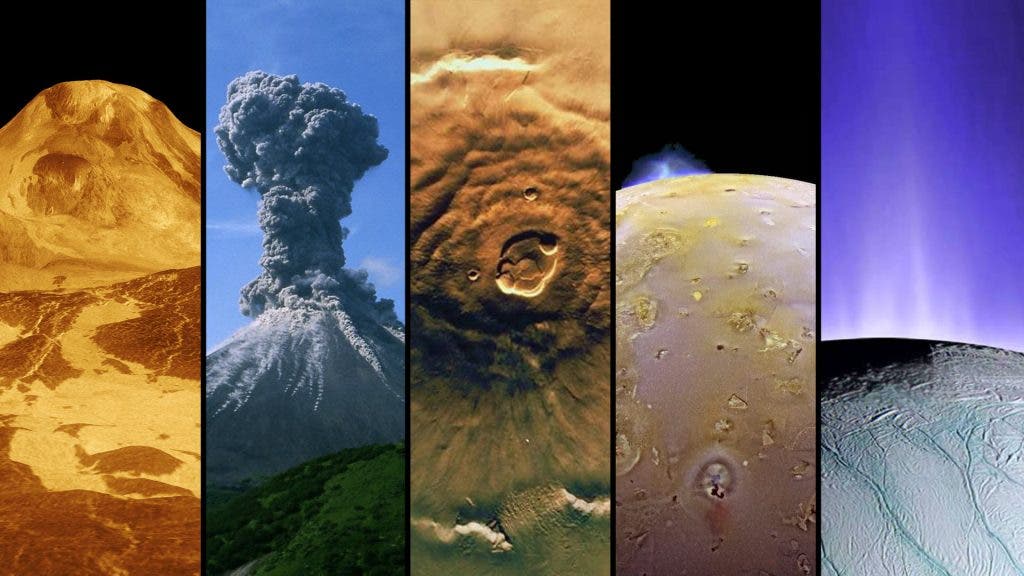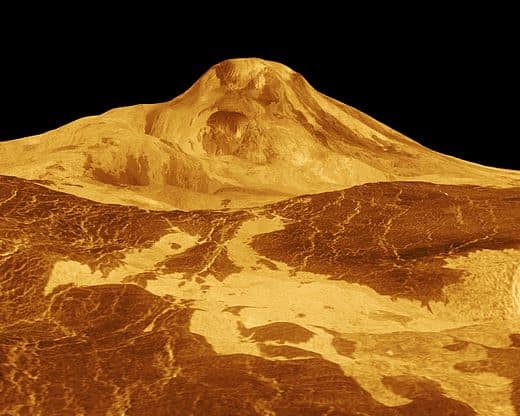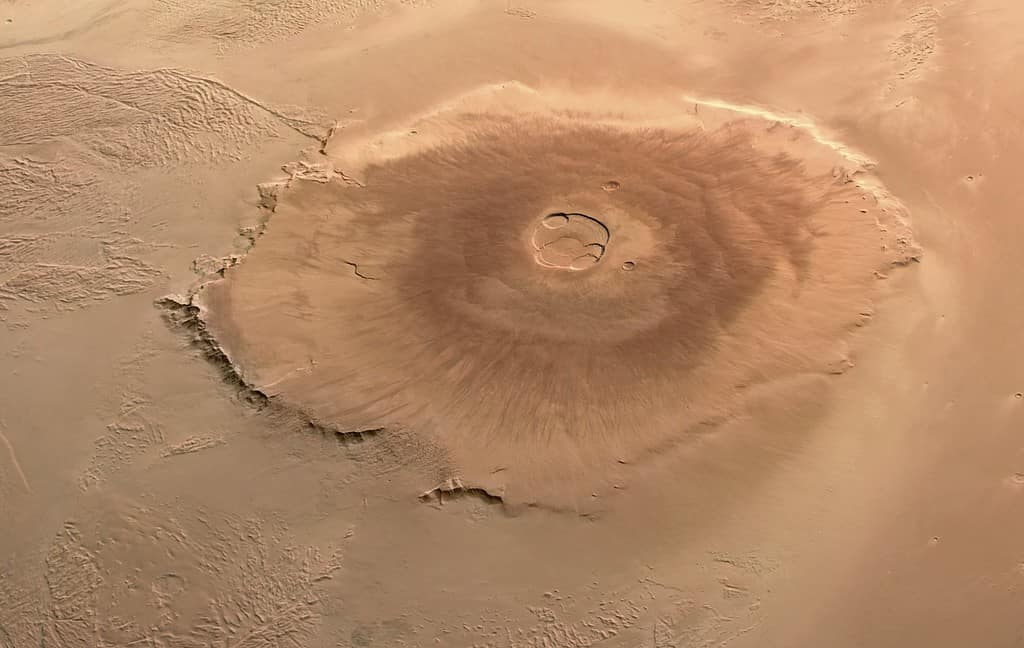Ever wondered what volcanoes on other worlds look like? Well, look no further!

Volcanoes have always captivated humanity, but their allure extends far beyond Earth. In fact, other words have volcanoes as imposing as Earth’s — or even more so. From planets like Venus and Mars to the surprising eruptions on moons like Io and Enceladus, these extraterrestrial volcanoes not only reshape our understanding of geological processes but also hint at the diverse environments where life might exist.
As we delve into the fiery and icy worlds of “volcanoes on other planets,” prepare to be amazed by the diversity and grandeur of volcanic activity beyond Earth.
Venus’ Maat Mons


Imagine a volcano so large it dwarfs many of Earth’s peaks, yet it sits on our celestial neighbor, Venus. Welcome to Maat Mons, one of the most colossal volcanoes in our solar system. This giant stands tall amidst Venus’ thick, toxic atmosphere, a testament to the planet’s fiery geological activity.
Unlike Earth’s volcanoes, Maat Mons is shrouded in mystery, partly due to Venus’ dense cloud cover. Recent data suggests it might still be active, with signs of lava flows that are relatively fresh in geological terms. What makes Maat Mons and Venusian volcanism stand out is the extreme conditions under which they exist – surface temperatures hot enough to melt lead and atmospheric pressure crushing enough to flatten a submarine.
Maat Mons challenges our understanding of volcanology. It’s not just its size or potential activity, but the way it has been shaped by Venus’ unique environment. Studying it provides valuable insights into not only Venusian geology but also broadens our knowledge of planetary science. When it comes to volcanoes on other planets, this one is definitely an impressive contestant.
Earth’s Karymsky volcano


We could have picked several volcanoes on Earth, but we went with one of the most remarkable and active ones, but also a lesser-known one: Karymsky, located in the remote Kamchatka Peninsula of Russia. This stratovolcano is a part of the Pacific Ring of Fire, a hotspot for seismic and volcanic activity. Unlike the shrouded Maat Mons of Venus, Karymsky’s eruptions are well-documented, offering a rich tapestry of data for volcanologists.
Karymsky’s eruptions are characterized by explosive activity and regular ash emissions, making it a key subject for studying volcanic gases and their impact on the environment. It serves as a natural laboratory, contrasting starkly with the enigmatic Maat Mons. The frequent eruptions of Karymsky allow scientists to observe and understand the dynamic processes occurring beneath Earth’s crust.
Karymsky is not a well-known volcano, but it is a striking one. It reminds us that while volcanoes may also exist on other planets, our own planet still holds many secrets in its fiery depths.
Mars’ Olympus Mons


Olympus Mons, the towering shield volcano on Mars, holds the title of the largest volcano in the solar system — heck, it’s the largest mountain in the solar system. This behemoth stands about 22 km high, nearly three times the height of Mount Everest, and spans approximately 600 km in diameter. Unlike the violent eruptions of Earth’s Karymsky, Olympus Mons’ size is attributed to the lower gravity of Mars and the lack of tectonic plate movement, allowing lava flows to gradually build up over millions of years.
The sheer scale of Olympus Mons is hard to comprehend. Its caldera, the summit crater, is large enough to contain the entire city of London. This Martian giant offers a stark contrast to Earth’s more familiar volcanic landscapes. The gradual lava flows have created a gently sloping profile, a unique feature among the volcanoes we’ve discussed.


Studying Olympus Mons provides invaluable insights into the geological history of Mars and the processes that shaped its surface. This colossal volcano is a window into the past, revealing the once-active volcanic nature of the Red Planet.
Io, Jupiter’s Volcanic Moon


Io, one of Jupiter’s moons, stands out as the most volcanically active body in our solar system. It’s not even close — Io is the most volcanic place in the solar system.
Its landscape is dotted with hundreds of volcanoes, some erupting plumes as high as 500 kilometers. This intense activity is primarily due to the immense gravitational pull from Jupiter, which causes significant tidal heating within Io’s interior.
The volcanism on Io is dramatically different from what we see on planets like Earth and Mars. Instead of slow-moving lava flows, Io’s volcanoes spew sulfurous plumes and molten silicate lava, painting a vivid and alien picture. The moon’s surface is constantly being reshaped by this activity, creating a dynamic and ever-changing landscape.
Io’s volcanoes are not just a spectacle; they provide crucial clues about the moon’s interior and the effects of tidal forces. Understanding Io’s volcanic nature helps scientists gain insight into the geological processes of other celestial bodies, enhancing our understanding of volcanoes on other planets and their diverse mechanisms.
Enceladus of Saturn
Enceladus, a small moon orbiting Saturn, presents a fascinating case of cryovolcanism – volcanoes that, instead of spewing hot lava, eject water, ice, and vapors. This icy world surprises astronomers with its active geysers, shooting plumes of water ice and vapor from its south polar region into space. In fact, these cryovolcanoes are one of the main clues that tell us some of these frozen moons hold liquid water.


Unlike the fiery eruptions seen on Io or the massive shield volcanoes like Olympus Mons, Enceladus’ cryovolcanoes are powered by internal heating, possibly caused by tidal interactions with Saturn. These icy eruptions contribute to Saturn’s E-ring, showcasing a different aspect of volcanic activity.
The study of Enceladus’ cryovolcanoes is particularly exciting because it raises the possibility of a subsurface ocean, a potential habitat for extraterrestrial life. This moon challenges our traditional view of volcanoes and extends it into the realm of ice and cold, adding a new dimension to our understanding of volcanism in the solar system.
From the towering Maat Mons on Venus to the icy eruptions on Enceladus, each of these celestial bodies showcases unique aspects of volcanism. Olympus Mons on Mars stands as a colossal monument to the Red Planet’s past, while Io’s intense volcanic activity underlines the dynamic processes at play in our solar system.
This exploration is as cool as it is useful. It not only broadens our understanding of geology and planetary science but also fuels our imagination about the possibilities of life beyond Earth. Each volcano, whether fiery or icy, tells a story of the cosmic forces shaping our solar system and offers a glimpse into the diverse and fascinating worlds that orbit our sun.
